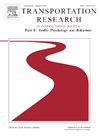灰色手机屏幕会减少开车和走路时的手机使用吗?探索性实验研究
IF 3.5
2区 工程技术
Q1 PSYCHOLOGY, APPLIED
Transportation Research Part F-Traffic Psychology and Behaviour
Pub Date : 2025-06-14
DOI:10.1016/j.trf.2025.05.029
引用次数: 0
摘要
移动电话分心是一个严重的全球道路安全问题,会导致车祸和随后的伤亡。这一问题已引起对有效干预的呼吁。基于神经心理学的研究表明,颜色刺激在推动手机使用方面发挥着重要作用,一个潜在的策略是在路上激活手机的灰度。通过去除颜色,与手机使用相关的感官奖励可能会减少,潜在地减少使用。然而,这种方法尚未经过实证检验。因此,本研究的目的是调查灰阶如何影响开车和走路时的手机使用行为。参与者被要求将他们的手机界面从彩色切换到灰度,持续两周。采用混合方法,包括调查和访谈,从参与者那里收集他们对开车和走路时手机使用行为的灰度感知的见解。定量结果显示,灰度降低了参与者在开车时看手机屏幕的频率。然而,使用灰度功能并没有导致参与者在开车时拿起手机看屏幕的频率发生显著变化,也没有增加参与者使用车载信息娱乐系统、智能手表或语音命令等其他设备的频率。此外,灰度显著降低了行人在走路时使用免提电话的可能性,尽管灰度并不影响看手机屏幕的可能性。定性结果显示,灰色等级对道路使用者的手机行为有复杂的影响。灰度改变了他们使用手机的方式,降低了手机的吸引力和乐趣,并增加了手机使用的复杂性。然而,一些参与者找到了解决办法,尽管不是每个人都采用了它们。总的来说,研究结果表明,虽然灰阶在两周的时间内有效地减少了一些与手机相关的行为,但它对开车或走路时使用手机的影响范围有限,在不同的环境下效果好坏参半,一些用户找到了变通的办法。本文章由计算机程序翻译,如有差异,请以英文原文为准。
Can greyscale phone screens reduce mobile use while driving and walking? An exploratory experimental study
Mobile phone distraction is a critical global road safety issue, contributing to crashes and subsequent injuries and fatalities. This issue has led to calls for effective interventions. Based on neuropsychological research indicating that colour stimuli play a significant role in driving phone engagement, one potential strategy to reduce road user phone use while on the road is activating greyscale on phones. By removing colour, the sensory reward associated with phone use may be diminished, potentially reducing usage. However, this approach has yet to be empirically tested. As such, the aim of this study is to investigate how greyscale influences phone use behaviours while driving and walking. Participants were asked to switch their phone interface from colour to greyscale for a duration of 2-weeks. A mixed-methods approach, including surveys and interviews, was employed to gather insights from participants regarding their perceptions of greyscale on their phone use behaviour while driving and walking. The quantitative results showed that greyscale decreased the frequency of participants glancing at their phone screens in a cradle while driving. However, using the greyscale feature did not lead to significant changes in the frequency of participants picking up the phone and looking at the screen while driving, nor did it increase participants’ use of other devices such as the in-vehicle infotainment system, smartwatches, or voice commands. Additionally, greyscale significantly reduced the probability of pedestrians using handsfree phones while walking, although greyscale did not influence the likelihood of looking at the screen of a handheld phone. The qualitative results revealed that the greyscale had a complex impact on road users’ phone behaviour. Greyscale altered how they used their phones, made them less appealing and enjoyable, and added complexity to phone use. However, some participants found work-around, though not everyone adopted them. Overall, the findings suggest that while greyscale effectively reduced some phone-related behaviours over a 2-week period, its impact on phone use behaviours while driving or walking was limited in scope, with mixed effectiveness across different contexts and with some users finding work-around.
求助全文
通过发布文献求助,成功后即可免费获取论文全文。
去求助
来源期刊
CiteScore
7.60
自引率
14.60%
发文量
239
审稿时长
71 days
期刊介绍:
Transportation Research Part F: Traffic Psychology and Behaviour focuses on the behavioural and psychological aspects of traffic and transport. The aim of the journal is to enhance theory development, improve the quality of empirical studies and to stimulate the application of research findings in practice. TRF provides a focus and a means of communication for the considerable amount of research activities that are now being carried out in this field. The journal provides a forum for transportation researchers, psychologists, ergonomists, engineers and policy-makers with an interest in traffic and transport psychology.

 求助内容:
求助内容: 应助结果提醒方式:
应助结果提醒方式:


